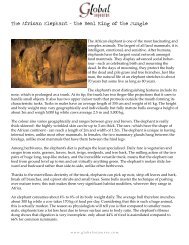The San People: Africa's Ultimate Survivors - Global Sojourns
The San People: Africa's Ultimate Survivors - Global Sojourns
The San People: Africa's Ultimate Survivors - Global Sojourns
Create successful ePaper yourself
Turn your PDF publications into a flip-book with our unique Google optimized e-Paper software.
and are still free to come up with their own choice. Like the rest of their lives, the <strong>San</strong> wedding ceremony<br />
is a simple affair. On a set day, the women apply a mixture of eland fat and red ochre on the<br />
bride. <strong>The</strong>y sing and make merry as they wait for the groom to return from his hunt. On return, the<br />
groom presents his hunt to the bride’s parents, and takes his bride away.<br />
<strong>The</strong> newly weds build their tent-house and start their little hearth. <strong>The</strong>y are free to choose whether to<br />
live with the bride’s or groom’s kin. <strong>The</strong>re is no immediate pressure to start a family; the women chew<br />
on a special tree bark which has contraceptive properties. If a marriage fails to work, the wife simply<br />
returns to her parents’ fireplace, without any life sapping drama.<br />
<strong>The</strong> <strong>San</strong> thrive on an economy of gift exchange. <strong>The</strong>y have little understanding of the concept of private<br />
ownership, as their demands on the world are so few. Since they are nomads, and are constantly<br />
on the move, movable wealth is an unwelcome burden. <strong>The</strong>re is little cause for trade as they share<br />
nearly everything they need, while the rest can almost certainly be picked from the<br />
bush with only a little exertion.<br />
Animal skins serve as clothing, while a nice robe can be made from fibrous and climber plants. Tools<br />
are made from stones, bones, sticks and occasionally, iron.<br />
<strong>The</strong> <strong>San</strong> and their peculiar way of life have always confounded many. You can tell this from the<br />
names others have bestowed on them. Some communities in Zimbabwe call them ‘Batwa’, a Bantu<br />
word meaning ‘people of the unknown’. In Zambia they are referred to as Amasili; Kwankhala in<br />
Angola; Basarwa in Botswana, and <strong>San</strong> in Namibia and South Africa.<br />
<strong>San</strong> is a Khoikhoi and Nama word meaning ‘outsider’. <strong>The</strong> Dutch called them ‘Boschjesmanne’<br />
meaning ‘people of the boschveld’, from which the name Bushman is derived. But the different Kalahari<br />
<strong>San</strong> communities call themselves by different names: for example, a Kalahari group living on the<br />
border of Botswana and Namibia call themselves the Ju/’hoansi, or “the real people.” <strong>The</strong> bushman<br />
term is however today considered to be derogatory, and in South Africa they are officially referred to<br />
as the <strong>San</strong>.<br />
<strong>The</strong> <strong>San</strong> people - and their culture and click consonant language- first came to the attention of the<br />
western world in the 1950s through Laurens van der Post’s book ‘<strong>The</strong> Lost World of the Kalahari’.<br />
This outstanding work was later turned into a BBC TV series.<br />
Many more people came to know of the <strong>San</strong> through the hilarious and unforgettable 1980’s movie<br />
“<strong>The</strong> Gods Must be Crazy”. In this movie, a <strong>San</strong> band encounters the marvels of the outside world in<br />
the form of a coke bottle which falls from a light aircraft. <strong>The</strong>y initially take the bottle to be a gift from<br />
heaven, but in the end come to see it as a curse. <strong>The</strong> documentary, ‘Bushman’s Secrets’ by<br />
Rehad Desai also gives an excellent introduction to the world of the <strong>San</strong>.<br />
<strong>The</strong> arrival of the Dutch and other colonials in the 17th century in <strong>San</strong> territory marked the beginning<br />
of a very difficult period for the <strong>San</strong>. <strong>The</strong>y experienced the most barbaric treatment ever meted<br />
on a people. <strong>The</strong> colonials did not concede their humanity- they viewed them as animals, and treated<br />
them as such. <strong>The</strong>y shot them at every encounter, and took over much of their land for farming and<br />
ranching.<br />
<strong>The</strong> Dutch also captured the <strong>San</strong> to serve as slaves and servants. For such a free ranging people, this<br />
was a terrible fate, and very few adapted well. <strong>The</strong> British on their part made attempts to civilize<br />
them first, and then domesticate them. <strong>The</strong>y met with little success, and thus begun to look at them as<br />
w w w. g l o b a l s o j o u r n s . c o m






